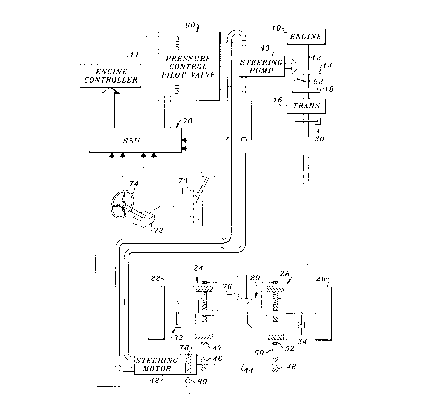Some of the information on this Web page has been provided by external sources. The Government of Canada is not responsible for the accuracy, reliability or currency of the information supplied by external sources. Users wishing to rely upon this information should consult directly with the source of the information. Content provided by external sources is not subject to official languages, privacy and accessibility requirements.
Any discrepancies in the text and image of the Claims and Abstract are due to differing posting times. Text of the Claims and Abstract are posted:
| (12) Patent: | (11) CA 2296249 |
|---|---|
| (54) English Title: | STEERING RESPONSIVE POWER BOOST |
| (54) French Title: | SERVOCOMMANDE SENSIBLE A LA DIRECTION |
| Status: | Expired and beyond the Period of Reversal |
| (51) International Patent Classification (IPC): |
|
|---|---|
| (72) Inventors : |
|
| (73) Owners : |
|
| (71) Applicants : |
|
| (74) Agent: | BORDEN LADNER GERVAIS LLP |
| (74) Associate agent: | |
| (45) Issued: | 2004-04-06 |
| (22) Filed Date: | 2000-01-19 |
| (41) Open to Public Inspection: | 2000-08-25 |
| Examination requested: | 2000-01-19 |
| Availability of licence: | N/A |
| Dedicated to the Public: | N/A |
| (25) Language of filing: | English |
| Patent Cooperation Treaty (PCT): | No |
|---|
| (30) Application Priority Data: | ||||||
|---|---|---|---|---|---|---|
|
A steering control system for a tracked vehicle includes an engine driven
variable
displacement steering pump which drives a hydraulic motor. A control system
senses
steering wheel position, vehicle speed, engine speed and forward/reverse
vehicle direction.
As a function of these sensed inputs, a control signal is generated and is
used to control the
swashplate angle of an engine-driven variable displacement pump which drives a
steering
motor which drives a differential track drive mechanism. The control system
also
determines a ratio of motor speed to vehicle speed and generates a powerboost
signal
when the ratio exceeds a threshold value. The powerboost signal is
communicated to the
engine controller which causes the engine to increase its power output. This
modifies the
engine fuel delivery curve based on the steering system power requirement and
increases
the power available for turning the vehicle.
Note: Claims are shown in the official language in which they were submitted.
Note: Descriptions are shown in the official language in which they were submitted.

2024-08-01:As part of the Next Generation Patents (NGP) transition, the Canadian Patents Database (CPD) now contains a more detailed Event History, which replicates the Event Log of our new back-office solution.
Please note that "Inactive:" events refers to events no longer in use in our new back-office solution.
For a clearer understanding of the status of the application/patent presented on this page, the site Disclaimer , as well as the definitions for Patent , Event History , Maintenance Fee and Payment History should be consulted.
| Description | Date |
|---|---|
| Inactive: IPC from MCD | 2006-03-12 |
| Time Limit for Reversal Expired | 2006-01-19 |
| Letter Sent | 2005-01-19 |
| Grant by Issuance | 2004-04-06 |
| Inactive: Cover page published | 2004-04-05 |
| Inactive: Final fee received | 2003-12-30 |
| Pre-grant | 2003-12-30 |
| Notice of Allowance is Issued | 2003-07-04 |
| Notice of Allowance is Issued | 2003-07-04 |
| Letter Sent | 2003-07-04 |
| Inactive: Approved for allowance (AFA) | 2003-06-16 |
| Amendment Received - Voluntary Amendment | 2001-05-09 |
| Application Published (Open to Public Inspection) | 2000-08-25 |
| Inactive: Cover page published | 2000-08-24 |
| Inactive: First IPC assigned | 2000-03-16 |
| Letter Sent | 2000-02-18 |
| Inactive: Filing certificate - RFE (English) | 2000-02-18 |
| Application Received - Regular National | 2000-02-18 |
| All Requirements for Examination Determined Compliant | 2000-01-19 |
| Request for Examination Requirements Determined Compliant | 2000-01-19 |
There is no abandonment history.
The last payment was received on 2004-01-05
Note : If the full payment has not been received on or before the date indicated, a further fee may be required which may be one of the following
Patent fees are adjusted on the 1st of January every year. The amounts above are the current amounts if received by December 31 of the current year.
Please refer to the CIPO
Patent Fees
web page to see all current fee amounts.
| Fee Type | Anniversary Year | Due Date | Paid Date |
|---|---|---|---|
| Registration of a document | 2000-01-19 | ||
| Application fee - standard | 2000-01-19 | ||
| Request for examination - standard | 2000-01-19 | ||
| MF (application, 2nd anniv.) - standard | 02 | 2002-01-21 | 2002-01-18 |
| MF (application, 3rd anniv.) - standard | 03 | 2003-01-20 | 2003-01-17 |
| Final fee - standard | 2003-12-30 | ||
| MF (application, 4th anniv.) - standard | 04 | 2004-01-19 | 2004-01-05 |
Note: Records showing the ownership history in alphabetical order.
| Current Owners on Record |
|---|
| DEERE & COMPANY |
| Past Owners on Record |
|---|
| BENJAMIN MICHAEL WITTE |
| DENNIS ROYAL YODER |
| JOHN WAYNE SCHLETZBAUM |
| LAWRENCE VERNON ANDERSON |
| RAYMOND YIFEI HOU |
| RONALD LEE MAYFIELD |
| SANJAY ISHVARLAL MISTRY |